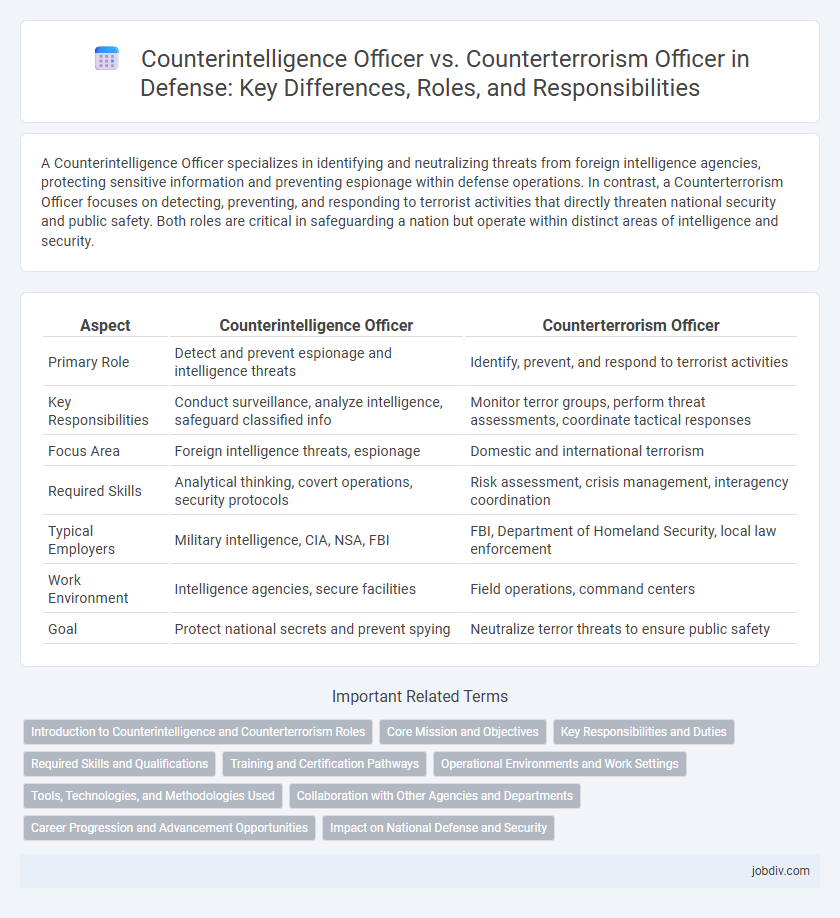A Counterintelligence Officer specializes in identifying and neutralizing threats from foreign intelligence agencies, protecting sensitive information and preventing espionage within defense operations. In contrast, a Counterterrorism Officer focuses on detecting, preventing, and responding to terrorist activities that directly threaten national security and public safety. Both roles are critical in safeguarding a nation but operate within distinct areas of intelligence and security.
Table of Comparison
| Aspect | Counterintelligence Officer | Counterterrorism Officer |
|---|---|---|
| Primary Role | Detect and prevent espionage and intelligence threats | Identify, prevent, and respond to terrorist activities |
| Key Responsibilities | Conduct surveillance, analyze intelligence, safeguard classified info | Monitor terror groups, perform threat assessments, coordinate tactical responses |
| Focus Area | Foreign intelligence threats, espionage | Domestic and international terrorism |
| Required Skills | Analytical thinking, covert operations, security protocols | Risk assessment, crisis management, interagency coordination |
| Typical Employers | Military intelligence, CIA, NSA, FBI | FBI, Department of Homeland Security, local law enforcement |
| Work Environment | Intelligence agencies, secure facilities | Field operations, command centers |
| Goal | Protect national secrets and prevent spying | Neutralize terror threats to ensure public safety |
Introduction to Counterintelligence and Counterterrorism Roles
Counterintelligence Officers specialize in identifying, countering, and neutralizing espionage threats to protect national security by preventing foreign intelligence agencies from gaining sensitive information. Counterterrorism Officers focus on detecting, preventing, and responding to terrorist activities aimed at disrupting public safety and government functions. Both roles require advanced analytical skills, situational awareness, and collaboration with law enforcement and intelligence agencies to mitigate threats effectively.
Core Mission and Objectives
Counterintelligence Officers focus on identifying and neutralizing foreign intelligence threats to protect national security by preventing espionage and insider threats. Counterterrorism Officers specialize in detecting, deterring, and responding to terrorist activities through intelligence gathering, analysis, and direct action to safeguard civilian populations and critical infrastructure. Both roles emphasize threat assessment and information security, but their core missions diverge between combating espionage-related risks and preventing terrorist attacks.
Key Responsibilities and Duties
Counterintelligence Officers specialize in identifying, preventing, and neutralizing threats posed by foreign intelligence entities through surveillance, analysis, and safeguarding classified information. Counterterrorism Officers focus on detecting, investigating, and disrupting terrorist activities by gathering intelligence, coordinating with law enforcement agencies, and implementing strategic response plans. Both roles involve critical risk assessment but diverge in scope, where counterintelligence centers on espionage threats and counterterrorism addresses acts of terror and related security breaches.
Required Skills and Qualifications
Counterintelligence Officers require strong analytical skills, proficiency in intelligence gathering, and a deep understanding of espionage tactics to detect and neutralize foreign threats. Counterterrorism Officers must possess expertise in risk assessment, crisis management, and tactical response, along with experience in threat identification and mitigation strategies. Both roles demand excellent communication abilities, security clearance, and comprehensive knowledge of national security protocols.
Training and Certification Pathways
Counterintelligence Officers undergo specialized training programs focused on detecting, preventing, and neutralizing espionage threats, with certifications such as Certified Counterintelligence Professional (CCIP) enhancing their expertise in intelligence analysis and security protocols. Counterterrorism Officers receive rigorous instruction in threat assessment, crisis management, and tactical response techniques, often pursuing certifications like Certified Anti-Terrorism Specialist (CATS) to validate their skills in counterterrorism strategy and operational planning. Both pathways emphasize continuous education through military and federal agency courses to ensure proficiency in evolving security challenges.
Operational Environments and Work Settings
Counterintelligence Officers primarily operate in clandestine environments, focusing on identifying and neutralizing threats posed by foreign intelligence services within government or military installations. Counterterrorism Officers often work in dynamic, high-threat settings such as urban areas, border security zones, and critical infrastructure sites, engaging in proactive measures to prevent terrorist acts. Both roles require collaboration with federal agencies and local law enforcement to respond effectively to intelligence gathered in diverse operational theaters.
Tools, Technologies, and Methodologies Used
Counterintelligence Officers employ advanced surveillance systems, cryptographic tools, and cyber forensics to detect and neutralize espionage threats, emphasizing HUMINT (human intelligence) and SIGINT (signals intelligence) methodologies. Counterterrorism Officers utilize real-time data analytics, biometric systems, and drone reconnaissance to track and disrupt terror networks, focusing on behavioral analysis and counter-IED (improvised explosive device) technologies. Both roles integrate geospatial intelligence (GEOINT) and collaborate with multi-agency fusion centers to enhance threat assessment and response capabilities.
Collaboration with Other Agencies and Departments
Counterintelligence Officers collaborate closely with the FBI, CIA, and military intelligence units to identify and neutralize espionage threats targeting national security. Counterterrorism Officers work alongside federal, state, and local law enforcement agencies, as well as the Department of Homeland Security, to prevent and respond to terrorist activities. Interagency information sharing and joint task forces are critical in enhancing operational effectiveness for both roles.
Career Progression and Advancement Opportunities
Counterintelligence Officers typically advance through specialized intelligence roles, gaining expertise in threat analysis, espionage detection, and national security strategy, often progressing to senior positions in intelligence agencies or military commands. Counterterrorism Officers focus on preventing and responding to terrorist threats, with career trajectories emphasizing operational leadership, crisis management, and interagency collaboration, leading to roles in federal law enforcement or defense task forces. Both career paths offer advancement opportunities through continued education, specialized training, and experience in high-stakes security environments.
Impact on National Defense and Security
Counterintelligence Officers protect national defense by identifying and neutralizing foreign espionage threats, safeguarding classified information, and preventing insider threats within military and government agencies. Counterterrorism Officers focus on detecting, preventing, and responding to terrorist activities that threaten civilian populations and critical infrastructure, thereby directly reducing the risk of attacks on homeland security. Both roles are crucial for comprehensive national security, with counterintelligence securing strategic secrets and counterterrorism mitigating imminent threats to public safety.
Counterintelligence Officer vs Counterterrorism Officer Infographic

 jobdiv.com
jobdiv.com